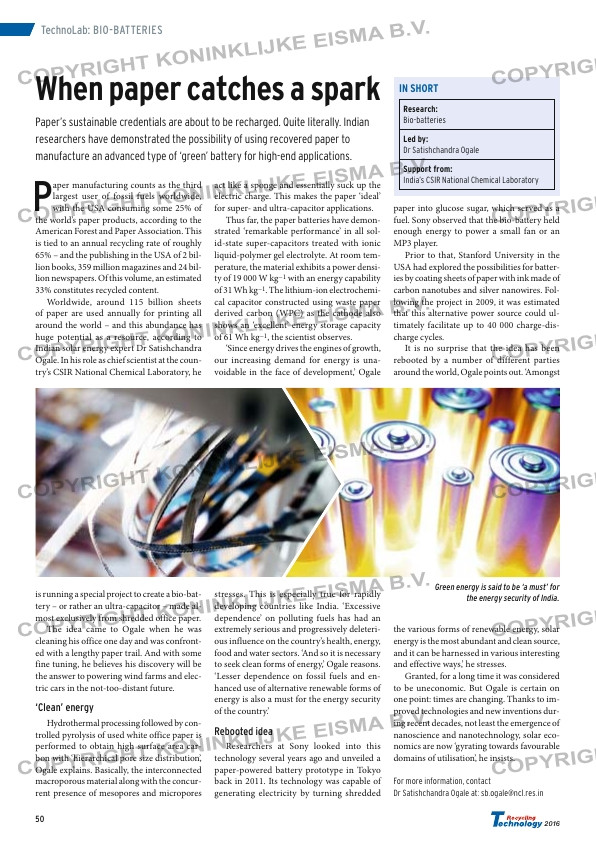Page 48 from: Recycling Technology 2016

50
2016
TechnoLab: BIO-BATTERIES
When paper catches a spark
Paper’s sustainable credentials are about to be recharged. Quite literally. Indian
researchers have demonstrated the possibility of using recovered paper to
manufacture an advanced type of ‘green’ battery for high-end applications.
P
aper manufacturing counts as the third
largest user of fossil fuels worldwide,
with the USA consuming some 25% of
the world’s paper products, according to the
American Forest and Paper Association. This
is tied to an annual recycling rate of roughly
65% – and the publishing in the USA of 2 bil-
lion books, 359 million magazines and 24 bil-
lion newspapers. Of this volume, an estimated
33% constitutes recycled content.
Worldwide, around 115 billion sheets
of paper are used annually for printing all
around the world – and this abundance has
huge potential as a resource, according to
Indian solar energy expert Dr Satishchandra
Ogale. In his role as chief scientist at the coun-
try’s CSIR National Chemical Laboratory, he
is running a special project to create a bio-bat-
tery – or rather an ultra-capacitor – made al-
most exclusively from shredded office paper.
The idea came to Ogale when he was
cleaning his office one day and was confront-
ed with a lengthy paper trail. And with some
fine tuning, he believes his discovery will be
the answer to powering wind farms and elec-
tric cars in the not-too-distant future.
‘Clean’ energy
Hydrothermal processing followed by con-
trolled pyrolysis of used white office paper is
performed to obtain high surface area car-
bon with ‘hierarchical pore size distribution’,
Ogale explains. Basically, the interconnected
macroporous material along with the concur-
rent presence of mesopores and micropores
act like a sponge and essentially suck up the
electric charge. This makes the paper ‘ideal’
for super- and ultra-capacitor applications.
Thus far, the paper batteries have demon-
strated ‘remarkable performance’ in all sol-
id-state super-capacitors treated with ionic
liquid-polymer gel electrolyte. At room tem-
perature, the material exhibits a power densi-
ty of 19 000 W kg−1 with an energy capability
of 31 Wh kg−1. The lithium-ion electrochemi-
cal capacitor constructed using waste paper
derived carbon (WPC) as the cathode also
shows an ‘excellent’ energy storage capacity
of 61 Wh kg−1, the scientist observes.
‘Since energy drives the engines of growth,
our increasing demand for energy is una-
voidable in the face of development,’ Ogale
stresses. This is especially true for rapidly
developing countries like India. ‘Excessive
dependence’ on polluting fuels has had an
extremely serious and progressively deleteri-
ous influence on the country’s health, energy,
food and water sectors. ‘And so it is necessary
to seek clean forms of energy,’ Ogale reasons.
‘Lesser dependence on fossil fuels and en-
hanced use of alternative renewable forms of
energy is also a must for the energy security
of the country.’
Rebooted idea
Researchers at Sony looked into this
technology several years ago and unveiled a
paper-powered battery prototype in Tokyo
back in 2011. Its technology was capable of
generating electricity by turning shredded
paper into glucose sugar, which served as a
fuel. Sony observed that the bio-battery held
enough energy to power a small fan or an
MP3 player.
Prior to that, Stanford University in the
USA had explored the possibilities for batter-
ies by coating sheets of paper with ink made of
carbon nanotubes and silver nanowires. Fol-
lowing the project in 2009, it was estimated
that this alternative power source could ul-
timately facilitate up to 40 000 charge-dis-
charge cycles.
It is no surprise that the idea has been
rebooted by a number of different parties
around the world, Ogale points out. ‘Amongst
the various forms of renewable energy, solar
energy is the most abundant and clean source,
and it can be harnessed in various interesting
and effective ways,’ he stresses.
Granted, for a long time it was considered
to be uneconomic. But Ogale is certain on
one point: times are changing. Thanks to im-
proved technologies and new inventions dur-
ing recent decades, not least the emergence of
nanoscience and nanotechnology, solar eco-
nomics are now ‘gyrating towards favourable
domains of utilisation’, he insists.
For more information, contact
Dr Satishchandra Ogale at: [email protected]
IN SHORT
Research:
Bio-batteries
Led by:
Dr Satishchandra Ogale
Support from:
India’s CSIR National Chemical Laboratory
Green energy is said to be ‘a must’ for
the energy security of India.



